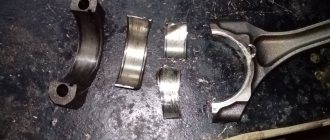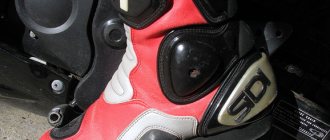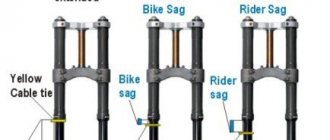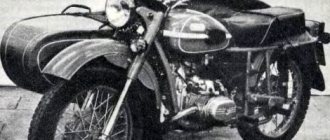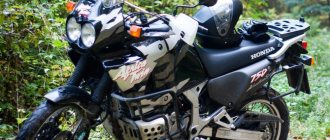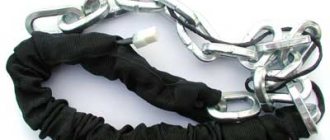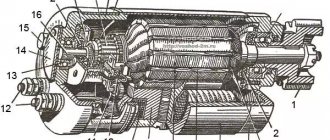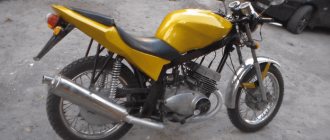Twenty tips for beginner motorcyclists
1. Always wear protective equipment.
The required minimum is a helmet, gloves, motorcycle boots, knee pads and a motorcycle jacket with built-in protection, or a “turtle.” Don't be lazy to wear a helmet, even if you are going to ride 100 meters. Nobody knows what could happen on the road in a second. 2. Before each ride, inspect the motorcycle: brakes, cables, clutch, light signals, and no damage to the tires. Check the oil level and tire pressure regularly.
3. Constantly improve your driving skills. Knowing how to brake and maneuver in an emergency can save your life. But remember, if you needed to use these skills on the road, you drove yourself into this situation without taking into account any factor, and proper safe driving involves avoiding extreme situations, not fighting them.
4. Obey the speed limit. Falling at speed in most cases leads to injuries that are often incompatible with life.
5. Do not seat a passenger unless you feel absolutely confident. Remember that braking distance will increase, cornering speed will decrease - you will not be able to control the motorcycle as much as when riding alone. Before the trip, give instructions on what the second number should do while driving and what absolutely should not do. Make sure that the second number always has equipment. Slow down and double your attention - now you are responsible not only for yourself, but also for the other person.
6. Keep your distance! Remember, the braking distance of a motorcycle is longer than the braking distance of a car, that is, if the vehicle driving in front of you suddenly brakes, if you don’t keep your distance, you will end up in its trunk. The “half speed” distance is considered safe, that is, if you are driving at a speed of 60 km/h, the distance should be 30 meters, if it is 90 km/h. – 45 meters.
7. Take a dominant position in the lane in which you are moving. It is not recommended to drive directly in the middle of the lane, there may be debris and oil stains, but do not press against the edge, so that drivers of passenger cars do not have the desire to fit in the same lane with you, which may cause you to be “squeezed” to the side of the road or onto the road. oncoming traffic
8. Cross tram tracks and any obstacles at an angle as close as possible to a straight line. Otherwise, a fall is very likely. Also, never brake on tram tracks, the rubber surface around them and on marking lines. Their coefficient of adhesion is much lower than that of the road surface; the wheels can skid, which will lead to a fall.
9. Before going through a turn, slow down in advance and choose a gear in which you will go through the entire turn. Braking while cornering can cause you to lose control of your motorcycle.
10. Your gaze should be directed to where you are going. To put it another way, the motorcycle always goes where your eyes are directed. Practice the habit of “taking turns with your eyes.” If, for example, a dog runs out onto the road and you look at it, a collision with it is inevitable.
11. A very common cause of road accidents is vehicles leaving yards and surrounding areas. When driving on a narrow road, secure all entries/exits and be prepared to apply emergency braking.
12. Pay attention to where the wheels of parked cars and cars standing in a traffic jam are pointing. If the wheels are turned out, there is a possibility that the car will make an unexpected maneuver and end up directly in front of you. The same with cars standing or slowing down near the center line in the oncoming lane. The driver could make a turn or U-turn right in front of you, the consequences could be fatal.
13. When driving in a traffic jam, you are always at risk that the driver or passenger may unexpectedly open the door without thinking about the possibility of a motorcycle being nearby. Never drive it faster than 15-20 km/h. Another danger is that pedestrians often try to cross the road in the wrong place when all the traffic is standing still, and they can suddenly run out right in front of you. Do not press against cars standing on the side of the road - their doors open just as thoughtlessly and unpredictably.
14. When driving in traffic, it is best to drive at its speed, controlling the situation around you, and not allowing cars to approach you at an unsafe distance. It is possible to drive 20% faster than the flow of traffic, but in this case you must remember that you become invisible to most road users and take this into account when choosing your distance, lateral spacing and maneuvers.
15. Learn to be visible and predictable to other road users. Serviceable lighting devices, additional motorcycle lighting, a bright vest and reflective elements are your passive safety.
Internal trajectory
Let's look at a standard right turn. Before turning right, you move slightly to the left, go through the turn in close proximity to the inner edge and exit in the left half of the lane. It would seem like an ordinary turn and everyone turns like that. But such a maneuver is not always completely safe. It’s good when oncoming traffic is not a threat and the next turn is in the same direction as the previous one. But there are also opposite cases when it is necessary to carry out a turning maneuver more safely, or as we called this method - “Internal trajectory”.
This method is safer due to the fact that a very large number of drivers drive into the oncoming lane before making a left turn. Our “internal trajectory” allows you to keep your distance from such drivers.
In addition, this type of rotation can be considered more effective. After all, most often, after a right turn comes a left one. This is not always the case, but quite often. That is why, in order to correctly enter the next turn, you need to exit the previous one inward, not outward.
Training these maneuvers can take place both on an empty site and on a road with a lot of turns. In the case of training on the road, you must be very familiar with the road.
Basic principles of the exercise when performing it on the road:
- The road on which the training takes place should be very familiar.
- There is no need to make turns quickly. They need to be implemented correctly.
- The entry point into the turn should practically coincide with the pre-steering point. This point is where the road begins to curve.
- The exact point of main steering will be the point from which you can see the exit from the turn. In other words, this is the point where the road begins to straighten out.
- Apex is the point at which the motorcycle’s trajectory is as close as possible to the edge. It should almost coincide with the exit point of the turn.
What you should pay attention to when training on an empty site:
This maneuver must be practiced for at least 60 minutes once a month.
How to ride a motorcycle: useful tips
Modern motorcyclists often ask questions regarding the correct way to ride their bike. Some believe that the main thing is safety, others are sure that they are not afraid of accidents, speed and comfort come first.
General provisions about motorcycles
Motorized transport dates back to the distant end of the 19th century. At that time, humanity saw the first motorcycle. Only, in fact, it was not a motorcycle, but an ATV, since it had four wheels instead of the required two. An engine with a power of 1/2 horsepower somehow set the wooden car in motion.
Today, no one can be surprised by the modern variety of two-wheeled vehicles.
There is a certain classification according to the purpose of motorcycles:
It is easy to guess that sports and racing motorcycles are designed for driving in race conditions, competitions, and so on. The same cannot be said about classic bikes. These vehicles are used every day for routine transportation to work, school, recreation and other places.
About how to ride a motorcycle
The choice of riding style on a two-wheeler greatly depends on the driver. Experienced motorcyclists answer questions about how to ride a motorcycle like this: “It depends on the gasket between the handlebars and the seat.” In fact, there cannot be any gasket between the handlebars and the seat of the bike. This name is assigned to inexperienced motorcyclists, newcomers to the biker business.
In order to start driving in the city, you should train quite a lot. As a rule, such training takes place on busy roads in rural or township areas, country roads, forests and fields.
It would seem that driving a small scooter or moped is not at all difficult. And this is true if you have minimal experience riding other two-wheelers. Riding powerful, heavy bikes (for example, Soviet road motorcycles “Ural”, “Dnepr” and others) is a completely different matter.
Features of heavy motorcycles
The curb weight of such a unit exceeds 180 kilograms, which is why it is classified as heavy. The engine capacity is often more than 400 cm3, which indicates significant power of a two- or three-wheeled vehicle.
Every second Soviet biker knew how to ride a Ural or Dnepr motorcycle. These large vehicles were used as a car. Particular attention should be paid to “Ural”. The brainchild of the Irbit motorcycle plant, as a rule, is used with a sidecar. Some Ural models have a so-called “cradle” wheel drive. The driver of this car has the ability to turn off the wheelchair drive.
To ride any other models of heavy motorcycles, it is important for the rider to have sufficient experience in driving such vehicles. If a bike of this size is used without a sidecar, which makes driving even more difficult, the driver must have a good sense of not only balance, but also anticipate possible braking difficulties and difficult road conditions.
About driving in bad weather conditions
A typical non-standard traffic situation for a motorcyclist is precipitation. Since few people ride motorcycles in winter, let's consider the change in weather during the warm season.
“How to ride a motorcycle in the rain?” – a seemingly trivial question, the answer to which is quite simple. In fact, there are a number of nuances and difficulties that may arise during such a ride.
It is no wonder that simple clothes will quickly get wet, as a result of which the rider can easily freeze. To prevent this, you should use special motorcycle clothing. This could be trousers and a jacket or overalls, boots, gloves and, of course, a helmet.
Driving in such conditions should under no circumstances be harsh or fast. Extreme caution will help the rider maintain control of his bike. The speed mode you should choose is medium rather than fast. Stop at traffic lights or intersections taking into account the doubling of the braking distance. That is, you need to start braking in advance, avoid sudden acceleration and strong leaning of the motorcycle when cornering.
Iron hatches, sometimes road markings, spilled lubricants are especially unsafe areas: in rainy times they have poor grip properties with rubber.
Illegal operation of a bike
It’s loudly said, but cases of illegal driving of vehicles, including motorcycles, occur quite often in the country. It is illegal to drive:
- Without a driver's license.
- Without a technical passport for the vehicle.
- In violation of current traffic rules and personal safety.
- Other conditions.
Almost every biker knows how to ride a motorcycle without a license. It is no wonder that the only difference between a driver with and without a license is the presence of the appropriate document. In fact, the level of skill of the “rider” directly depends on the riding experience.
To the question “how to ride a motorcycle without documents” the answer will be: “Ride with minimal violations.” In other words, you should not attract the attention of traffic police officers, namely:
- Be sure to drive the bike in accordance with the rules of the road, and do not forget about the helmet.
- It is not advisable to drive a challenging motorcycle, since compliance with the technical passport of some of the vehicle’s upgrades (if any) may raise doubts among traffic police officers.
- In the city, in traffic police patrol areas, do not drive a motorcycle provocatively.
No license plate
How to ride a motorcycle without license plates, and is it possible to drive a bike without a state license plate? The answer to the question is obvious - this directly contradicts the current traffic rules. Driving a vehicle without a license plate is only permitted if it has recently been lost. Undoubtedly, such motorcycles will definitely attract the attention of traffic police officers.
If the motorcycle is operated far from the city or in an area where traffic control is rare or does not occur at all, riding without license plates is quite possible.
A smart driver who is well acquainted with traffic rules, has legal knowledge, and even better, if directly related to this, will not have any difficulty convincing the law enforcement officer of the authenticity of all documents and the legality of driving.
In turn, a competent inspector has every right to check the information provided. Therefore, driving without license plates is quite dangerous. Punishment for such tricks can be completely different: from a fine to confiscation of a vehicle in especially aggravating circumstances.
Punishment for illegally driving a motorcycle
Russian legislation provides for penalties for driving a vehicle without the appropriate document:
- For driving a vehicle by a driver who does not have a license or documents with him, punishment is provided in the form of a warning or a fine of 500 rubles.
- For driving without a driving license (if the “rider”, in principle, does not have a license) a fine of 5,000 to 15,000 rubles is provided.
Based on the above points, we can conclude that it is not worth getting caught by traffic police with such violations.
In case of arrest, it is much more cost-effective to convince the traffic police officer that the necessary documents were left at home or in the garage, honestly repent and promise that this will not happen again. In this case, an adequate inspector will limit himself to a fine or even let the rider go unpunished. Oddly enough, but this also happens.
How to ride a motorcycle number two
It is believed that being a passenger in a two-wheeler is somewhat safer. This is not just a rumor or someone's opinion. According to statistics, in road accidents, especially with a frontal motorcycle impact, the first number takes the brunt of the impact.
Most often, the passenger of a sports bike is higher than the driver, which can save his life in case of a sudden stop. In other words, the passenger flies over the driver, while the driver takes the full brunt of the impact on his body.
Regarding control, the passenger should not forget, first of all, about his own safety. This, of course, requires appropriate equipment, feet on the footrests, but not on mufflers or in weight, a strong grip on the first person or on the provided handrails.
During sharp acceleration, turning or braking, the second number should carefully repeat the maneuvers of the first, as this will make it possible to control the balance of the car.
You don’t need to read literature or have any special knowledge about how to ride a motorcycle number two. The main thing is that you should not be distracted, jump off or get on the bike while moving (but you probably won’t even have to be reminded about this).
About driving on the highway
Now let's talk about how to ride a motorcycle on the highway, or how to ride safely on the highway. These points are worth examining point by point:
- A novice biker does not need to give in to the temptation to accelerate his bike to the maximum permissible maximum speed on this road section, not to mention the maximum speed of the motorcycle itself.
- Given the road conditions, it is important for even an experienced rider to be extremely careful.
- Under no circumstances should you drive closely behind other road users; you should always keep your distance.
- Perform overtaking and other maneuvers in the prescribed manner, making sure that this does not create an emergency or dangerous situation on the road.
- In case of unforeseen situations involving the motorcycle itself or without it, if possible, stick to the far right lane.
Let's sum it up
A motorcycle is an effective and economical means of transportation in the modern world of crowded roads and time constantly moving forward.
The choice of motorcycle depends on the driver’s preferences regarding style and riding style. The driving experience of the “rider” is of considerable importance. The more experience, the less likely it is to make one or another mistake while driving a motorcycle.
How to ride a motorcycle in the rain, driving on the highway, without license plates and documents, is described in the sections above, based on personal driving experience. A delicate point will also be mentioned. It's like riding a motorcycle without a license. However, it is better not to do this for your own safety and the safety of other road users.
Practice winter driving
Cold and wet roads. Slippery areas. Winter is full of (not very pleasant) surprises for the motorcyclist. Since you need to be prepared for anything, you should practice winter motorcycle driving.
But how to do that?
In our driving school we offer a service that is the first and only in Belarus. Thanks to it, you can practice driving a motorcycle in winter, learn how to ride safely and well on snowy or icy roads, and simply ride with an experienced instructor who will tell you about all the intricacies of driving in winter.
A little about the service:
The cost of one session is 33 rubles. For an hour of training, which consists of 3 races of 10 minutes each and consultation with a master, equipment and documentation.
If you want to ride on your own, that is, without an instructor, then you have the opportunity to ride on a specially equipped track, which in terms of conditions is similar to a road in winter.
You can also ride yourself in any free time. What's the best way to do this?
Just go to the nearest supermarket parking lot on a Sunday and practice without assistance, but riding a motorcycle in the city in winter is not safe.
Start very slowly and gradually speed up. Be patient and practice braking at different speeds. You need to understand how your motorcycle will respond to lighter and more powerful brakes.
What is it for?
When you apply the rear brake first, you lower the bike's center of gravity, increasing its stability. And by gradually squeezing the front brake, you give your motorcycle time to transfer its weight to the front wheel before applying additional braking force. With the added weight, the front wheel will be able to effectively stop your motorcycle.
How to learn to ride a motorcycle: tips
A motorcycle is dangerous! Always remember this! But besides the risk and danger, this two-wheeled vehicle can also give you a lot of joy, adrenaline and new sensations.
In this article, I will try to describe my experience of starting to learn to ride a motorcycle. I’ll say right away that I don’t have much experience yet, but nevertheless, I will at least describe my training and first trips to the city on a moto.
My riding experience
It didn’t work out for me with cars and other vehicles with motors. But on a bicycle, I rode for about three seasons. Well, I had a category B license. It’s true that I didn’t go anywhere other than driving school.
In general, a motorcycle, and especially an ebr, is very similar in handling to a bike, only a little heavier :-). Therefore, keeping my balance and turning the steering wheel was quite familiar and easy for me. But it took time to master the technique of clutching and starting.
What I learned in garages
My motorcycle is stored in a garage, which is located in a garage cooperative. And there is a place to travel quietly without going into the city.
That's why my first training trips were in garages :-). Actually, it took me the longest to learn how to start. At first I often went deaf. But with practice, I learned to start driving almost without stalling. And the Internet helped me get started correctly :-).
1) Learn to move away
The main secret to starting off on a motorcycle is to SMOOTHLY release the clutch . Even if the bike already seems to be moving, do not release the clutch lever, but ALWAYS release it further. And the likelihood of stalling is sharply reduced.
2) Learn to change gears
After mastering the starting technique. I learned how to change gears. From first to second and further, and back, from third to second and first. The first gear on the YBR 125 is short, which means that as soon as you set off, you need to engage second gear. All gear changes are performed only with the clutch depressed. In general, proper switching will only come with practice. Therefore, to begin with, just drive around the site (in my case, the garages). You need to feel the engine and the motorcycle.
Basically, after I had a lot of fun on the site, I put on all my gear and went to the city.
First rides into the city on a motorcycle: scary, very scary, normal
After the garages, I decided to go into the city for the first time on a moto. Considering that I had been actively cycling before, I decided to start by simply riding slowly in the far right lane, like a cyclist. Well, this is not always convenient or possible. But in general, driving there is not as scary as in the middle and left lanes :-).
1) See the signs
I knew the traffic rules, so the only difficulty that arose was seeing the signs. Alas, you can only learn to see the signs with experience. Therefore, it is better to drive slowly, 30-50 km per hour.
2) Traffic lights and zebra crossings, speed reduction, gear shifting
At first, traffic lights are a pain in the ass, because you have to stop at them. And by the way, it’s easy to stop. To change gears, simply hold the clutch and press the gear shift foot all the way down (this way you will just have the first gear for later starting).
Well, I learned how to get going in garages. Accordingly, it’s not so scary at traffic lights.
3) Give way
The situation is more complicated with priority signs, such as “give way.” You kind of slow down, but not completely. If I have a main road, I always look at the driver on the secondary road to see if he can see me. And when I see what he sees - and gives way, I put on the gas - to drive faster.
In general, with the third trip to the city, I felt more confident on the road.
Don't ride for long!
Firstly, I get tired from driving in the city, I need to be VERY CAREFUL. Therefore, I do not recommend riding more than 2-3 hours a day. And I advise you to take a break every hour.
If you ride a motorcycle for a long time, you will lose attention and the likelihood of getting into an accident will increase. Therefore, learn to ride a motorcycle gradually and little by little and be sure to wear all the equipment + TURN ON LOW BEAM HEADLIGHTS .
I ride too
I also learned this way, I drove a car and the principle of working with the clutch is the same. Plus, before buying, when at first I wanted to take Planet 5, I came across a video where an instructor teaches a blonde to ride a fucker, that’s where he explained that when you release the clutch and the first contact appears, you must continue to hold this place perfectly until you drive 5 meters and slowly release further . I took the Centurion 125, although its first name is Stels SB 200. Its first gear is also short, I started off and immediately went into second, and so on. In the evenings I drive around the village when there are few cars and there are not so many people drunk in the evening. Soon the first maintenance will take place at the 300 kilometer mark, I need to go to the city for maintenance, so while in the village I am training to pass intersections and so on, I just need to practice with traffic lights, they will definitely be there. I'll probably go early in the morning so that there are fewer cars. I’ve already compiled a whole list of 2 sheets of what’s wrong with my bike and what needs to be corrected, except for what I did myself: I fell on my right side at 10 km/h on a bump with a passenger, rearing up and lying down. I scratched it a little, just a little, bent the driver's leg on the right, also quite a bit, scratched the housing of the right mirror, it was all on a primer, you won't find such bumps on our asphalt, the patches are just like a chessboard on the road. In general, I quickly got used to the moto and got used to its weight. Today I rode a bike for the first time in 3 days, damn it’s so hard to turn the pedals to go even a little and what a stupid landing and control! Although before the bike seemed very comfortable to me, today I felt like I was at a height of four meters on a very short and unstable trainer on the road. How I used to live without a motorcycle, it’s a very responsible thing, but very interesting and exciting.
Evasion
The last two exercises are intended for ordinary and quite predictable situations. But there are a lot of unpredictable situations on the road. They are regularly created by both drivers and pedestrians. An exercise called “Evasion” was created in order to learn how to avoid unexpected obstacles on the road. This exercise combines the last two exercises.
Basic rules for this maneuver:
- Correct speed. It is necessary, first of all, to adjust the speed of the motorcycle. This does not mean that you need to slow down; in some cases, on the contrary, you need to speed up a little. But in most cases, you need to slow down in front of an obstacle. In this case, even if you fail to evade and a collision occurs, then at a lower speed there will be less critical consequences. Sometimes it happens that nimble acceleration helps carry you away from an oncoming obstacle.
- You need to evade only in cases where it is necessary. In case of braking, you will have additional time to think again and make the right decision. Remember, if you decide to dodge, you won’t be able to accelerate back. This is a kind of point of no return.
- It is necessary to separate braking from steering. The friction force is not infinite, and if most of it is spent on braking, then it may not be enough for the centrifugal force. In the most critical cases, steering and braking are applied to the fullest; there is definitely not enough friction force to combine them. This is followed by three scenarios: 1) the front wheel is demolished and the driver falls; 2) rear wheel drift and lowside; 3) rear wheel drift and highside (this is only if everything was done incorrectly). It is important to note that in this situation, even the ABS system, on which most people place high hopes, cannot help.
All unexpected obstacles on the road are divided into two types. The first are those that occur on straight sections of the road. These could be cars, pedestrians, animals, potholes on the road. The second ones are the same obstacles, but on turns.
Before you get behind the wheel of your motorcycle, you need to have a detailed evasion plan in mind. All actions must be practiced until they become automatic. There are, of course, unusual situations, but in most cases, on a straight section of the road, braking or braking, and then evading, has proven to work best. When cornering, co-steering usually saves the day, and in some cases in combination with braking.
But there are also situations in which you can immediately use evasion. These are completely predictable situations, for example: a hole in the asphalt, debris or a small object on the road. If such objects appear on the road, you can avoid emergency braking. It is enough to just slightly change the direction of the vehicle's trajectory.
Basic principles of evasion:
- It is important to remember that a normal evasion is two counter-steerings that are combined into one.
- The head should, as always, be in a strictly vertical position, which will ensure a horizontal view.
- The effect of an evasive maneuver depends primarily not on the force of pressure on the handle, but on the duration of this pressure.
- It is important to remember that braking must be completed before taxiing begins.
- It is necessary to try to evade at a short distance from the obstacle. Dodging at a distance of 1.5-2 meters from the object is considered ideal.
- You can't heal your hands. They hold onto the motorcycle better with their feet.
- This is a gradual exercise. First, learn to brake sharply and reduce speed to 15-20 kilometers per hour. If this seems too easy, try braking later.
- Remember to downshift when braking.
- The average car is 4 meters long. Therefore, it is necessary to evade at a distance of at least three meters from the line of movement.
- Look not at the object of evasion, but at the detour trajectory.
- After the second taxi, you need to level the motorcycle and add a lot of gas.
- During training, create symmetrical obstacles that will give you the opportunity to practice maneuvers when moving in both directions.
- It is better not to use a real car during training. After all, in the initial stages, something may not go according to plan. This can be very dangerous.
You need to train and perform evasion for at least 60 minutes once a month.
To improve your skill, you can increase the initial speed.
To help a newbie
Who among us has not cast envious glances towards the luxurious, fast vehicles that are motorcycles? How many people have thought about what problems their owners face with the acquisition of “iron beauties”? Firstly, there are many hunters for other people's goods. The likelihood of a motorcycle being stolen on city streets in the absence of the owner is quite high. And you can’t leave such a unique toy near your house overnight. So you need a garage. Secondly, riding a motorcycle requires certain skills and abilities. Especially in a metropolis. You will have to pay for such an experience with a considerable number of abrasions and bruises. Thirdly, to ride a motorcycle you need appropriate equipment - helmet, suit, gloves. All this plays an important role - protection from wind, cold, dirt, a softening agent in case of unplanned contact of the body with the asphalt during a fall. And, of course, such a uniform is part of the image of any motorcyclist. And finally, the most important thing. A good motorcycle costs good money. Are you ready to sacrifice a large amount of money from your wallet? But a motorcycle requires constant cash investments. Its operation involves the consumption of gasoline, repairs, modernization, and improvement of appearance. It's a troublesome and financially expensive matter. If all these circumstances do not stop you, if your decision to buy a motorcycle is firm and balanced, then all the following tips are intended just for you.
The choice of motorcycle should be determined, first of all, by your financial capabilities and, of course, the convenience of this vehicle. For a novice motorcyclist, a model that has a minimum of plastic components and an average engine capacity is suitable. This is due to the fact that at first it is still too early for you to “compete with the wind”, but it is quite possible to learn basic driving techniques using such a unit. Plastic parts quickly break and get scratched when dropped. In addition, you should decide for what purpose you need a motorcycle. If you want to test yourself in high-speed racing, then a sports motorcycle will suit you. If you are a sedate and even respectable person, then your model is a cruiser. For normal travel on smooth roads, a road driver is acceptable. Well, if you want to do a lot of pirouettes on different surfaces, then you will definitely need an enduro.
A suit for a motorcyclist will cost a pretty penny. A good helmet will save your head if you fall at a decent speed, and a motorcycle suit and gloves will prevent your skin from being torn off by asphalt and snags. It’s really not worth skimping here.
Before you climb onto the “iron horse,” do a thorough inspection of it before your ride. Check oil levels, brakes, clutch. Pay attention to the presence or absence of puddles under the motorcycle and smudges on the fork. This is a signal of impending danger. If you treat it with indifference, then unpleasant surprises await you on the road. For example, at the next turn the motorcycle’s grip on the road will be reduced to zero, and then an accident is not far away. In general, try to do timely maintenance and repairs of your motorcycle so that traveling on it is a pleasant pastime for you, and not a hectic bustle and forced rummaging through its broken “internals.”
For confident control, familiarize yourself with all the buttons and knobs present on the control panel. Understanding their purpose and clearly working with them will help you quickly master a new technique. If the motorcycle has a center stand, then this will allow you to simulate riding a motorcycle. You will be able to understand how the different components of your motorcycle work without going out on the road. To do this, simply place the motorcycle on the stand so that the front wheel is on the ground and the rear wheel is hanging in the air. You can calmly land on the seat, start the motorcycle, squeeze the clutch, engage the gear, add gas. Just don't overdo it in your studies. After all, there is too much CO in the exhaust gas. Why should you be poisoned by it?
To begin with, choose flat, traffic-free sections of the road for driving. And don't accelerate right from the start. Otherwise, you will experience not the joy of the trip, but the danger of “flight”.
The mode of your first trip should be like this - you start a little, drive a few meters, stop. This way you will be able to understand how the clutch and brakes work, what happens when you accelerate. All this will give you confidence in your movements and awareness of what is happening.
After such activities, you can go out onto the city streets, but do it with caution. Do not choose the central, overly busy streets of the metropolis. And don't travel during rush hour. For your first trips around the city, morning hours and uncrowded streets are quite suitable. Don't create problems for yourself or others. It is better to choose a wide road, with visible sides, with traffic lights and intersections. And the weather is also worth paying attention to. Clear, dry weather will contribute to good visibility and better stability of the motorcycle on the road. And a wet or icy roadway prepares an inexperienced motorcyclist a lot of unpleasant surprises, the outcome of which is associated with obvious danger. To begin with, drive slowly. The main thing for you is to learn how to drive a motorcycle correctly and control it accurately. As your confidence in your own success grows, you can gradually increase your speed limit.
When you return from your ride, try to become aware of how your body feels the moment you get off the bike. If it’s hard for you, your body aches, your arms are cramped, it means you’ve been under tension all the time. It turns out that you don’t yet have that freedom of movement that separates a novice motorcyclist from an experienced biker. Analyze all the moments of your trip, find out what exactly makes you tense, what makes you nervous, what you focus on while driving along the road.
On the road, remember that mirrors on a motorcycle do not exist for beauty or for narcissism in front of them. The rearview mirror will allow you to assess the situation around you on the road and avoid getting into trouble. Turn signals are also not given to the motorcycle for decoration or illumination. By turning on the turn signal, you let the vehicle following you know about your intentions, which will also, of course, help you avoid various accidents.
Don't try to joke with the markings on the road. It is applied to the road surface to eliminate chaos in traffic and distribute all road users into certain rows. Sometimes the markings are not applied with paint, but are made of plastic. If you decide to drive along it, you may feel like a hockey player on ice when braking sharply. Only instead of clubs and opponents in this case, other vehicles will give you both. Which again can lead to an accident. By the way, longitudinal cracks in the asphalt are also dangerous for light motorcycles. It's easy to get stuck in them, but if you do it at full speed, then the injury if you fall from the motorcycle will become very serious. Don't lose sight of the rut either. In this case, maneuvers should be done very carefully. Uneven surfaces in the form of pebbles and potholes will not bring you and your motorcycle any joy. Rocks flying in all directions can cause injury to the motorcyclist. It is better to cross tram tracks and railway crossings at obtuse and right angles. This will save you from the difficulties that arise in this case.
If you have to ride in the rain, then, most likely, when you exhale sharply, the helmet glass may fog up due to high humidity. Simply raise the glass to improve visibility and visibility. Throw a raincoat on yourself at such a moment, otherwise you will get wet and freeze.
On the road, stay behind the right wheel of the car in front of you. This is due to the fact that this makes it easier for you to avoid collisions with dangerous objects that abound on our roads, and which cars usually pass between the wheels. In addition, such a position allows you to change lanes in time and overtake, of course, only prudently. If you suddenly decide to drive between the lanes, do not forget that in this way you find yourself in a “dead visibility” zone, and when you open the door of the car in front of you, you may even get hit by a flying cigarette butt or spit.
Get into the good habit of keeping your fingers close to the brake lever. This is not very convenient, but it gives a gain of several seconds at the time of emergency braking.
Have a nice motorcycle trip. Enjoy the space, freedom and speed, but do not forget that you are not alone on the road, which means that no one has canceled the rules of the road.
Don't imagine the entire traffic situation
Firstly, stop looking under the wheel and only straight ahead. Beginners are always scared, but you have to fight it. A motorcyclist is obliged to watch the road even more carefully than a motorist, because you and I do not have a safety cage, a belt will not hold us in the saddle and an airbag will not jump out of the steering wheel.
Secondly, if you don’t have a complete picture of the traffic, then at least you won’t wait for surrounding traffic to change lanes or turn; I’ll say nothing about pedestrians. You may object:
- I can’t know the road maps of the entire city by heart, but what if I find myself in an unfamiliar place?
It is not necessary to know every gateway, it is enough to understand the principle of movement on your site and the approximate plan for the development of events ahead, which can be read from the markings and signs. Beginner motorcyclists sometimes concentrate only on their lane, without even realizing that danger may come from the other side. Or they begin to frantically change lanes when they realize that they are turning from another lane.
And as for other cities... It’s better to look at the map before leaving, at least along the main streets and avenues, so as not to get into a stupid story. And if you know drivers, why not chat with them? Would it really be difficult for your friend to warn you about a dangerous intersection or turn that is easy to miss?
"The feeling of speed while riding a motorcycle"
“What do you need to remember during the opening of the motorcycle season?”
